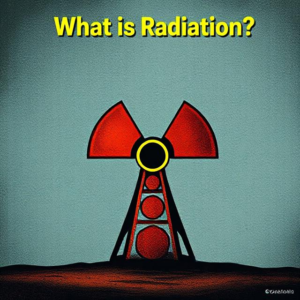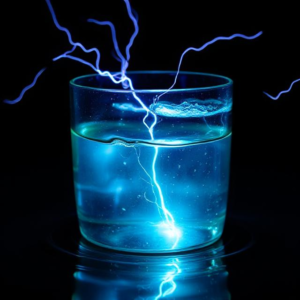Ionizing Radiation
Ionizing radiation refers to types of energy that can remove tightly bound electrons from atoms, creating ions. This process happens when high-energy radiation strikes an atom, knocking electrons out of orbit. The result is an ion, which is an atom or molecule with a charge due to the loss or gain of an electron.

- What is ionizing radiation?
- Ionizing radiation is a type of radiation that has enough energy to ionize atoms or molecules. This means it can remove electrons from atoms.
- This radiation comes in different forms, such as alpha particles, beta particles, gamma rays, and X-rays.
- Where does it come from?
- Natural sources: It comes from cosmic rays (from outer space), rocks, soil, and even our own bodies (like potassium-40 in our cells).
- Man-made sources: Medical treatments like X-rays, nuclear reactors, and some industrial processes also produce ionizing radiation.
- Why is it called “ionizing”?
- The term “ionizing” comes from the fact that the radiation carries enough energy to ionize atoms — meaning it can knock electrons off atoms and create ions. This can be dangerous because when the atoms in living tissues are ionized, it can lead to cell damage or mutations.
- Types of Ionizing Radiation:
- Alpha particles: These are large, heavy particles that can be stopped by something as thin as a sheet of paper. However, if alpha particles are inhaled or ingested, they can be harmful.
- Beta particles: These are smaller than alpha particles and can penetrate through paper, but can be stopped by materials like plastic or glass.
- Gamma rays and X-rays: These are high-energy electromagnetic waves (like light, but much more powerful). They can penetrate deep into materials, including human tissue, and require dense materials like lead or thick concrete to stop them.
- What are the effects of ionizing radiation?
- Ionizing radiation can be harmful if a person is exposed to large amounts. It can damage or kill cells and even lead to cancer or genetic mutations. However, low levels of exposure, like getting a dental X-ray or spending time outside, usually don’t cause harm.
Types of Ionizing Radiation
There are several types of ionizing radiation, each with its characteristics and properties. The four main types are:
- Alpha Radiation (α)
- Alpha particles consist of two protons and two neutrons, making them relatively heavy and positively charged.
- They are produced in the decay of certain heavy elements, like uranium and radon.
- Alpha particles have low penetration power and can be stopped by a sheet of paper or human skin. However, if alpha-emitting substances are inhaled or ingested, they can be very dangerous.
- Beta Radiation (β)
- Beta particles are high-energy, high-speed electrons (or positrons) that are emitted from the nucleus of a radioactive atom during decay.
- Beta particles are more penetrating than alpha particles but can typically be blocked by materials like plastic, glass, or a few millimeters of aluminum.
- Beta radiation is often associated with the decay of lighter elements, such as carbon-14 and tritium.
- Gamma Radiation (γ)
- Gamma rays are electromagnetic waves (photons) with very high energy and short wavelengths.
- Gamma radiation has high penetration power and can pass through the human body, requiring dense materials like lead or several centimeters of concrete to shield it effectively.
- Gamma rays often accompany alpha or beta decay and are common in radioactive materials like cobalt-60 and cesium-137.
- X-rays
- X-rays are also a form of electromagnetic radiation, similar to gamma rays but generally produced by the interaction of electrons with matter (such as in an X-ray machine).
- X-rays have energy levels between ultraviolet light and gamma rays, and they can be absorbed or scattered by the body.
- X-rays are used in medicine for imaging but also carry ionizing radiation risks.
- Neutron Radiation
- Neutron radiation consists of free neutrons that are typically produced in nuclear reactions.
- Neutrons are highly penetrating and require specific types of shielding (e.g., water or polyethylene) to protect against them.
- Neutron radiation is significant in nuclear reactors and certain types of radiation therapy.
How Ionizing Radiation Affects Matter
When ionizing radiation interacts with matter, it transfers energy to atoms and molecules, knocking electrons out of their orbits. This process can cause the following effects:
- Direct ionization: The radiation directly strikes atoms and molecules, causing them to lose electrons and form ions. This can lead to molecular damage in cells, which is a major concern for biological systems.
- Indirect ionization: The radiation can interact with water molecules (a key component of living cells) to produce free radicals, which are highly reactive particles that can damage cellular components like DNA.
The damage caused by ionizing radiation can result in:
- Cell death: If the cell cannot repair the damage, it may die.
- Mutations: If the DNA is damaged but the cell survives, the mutation can be passed on to subsequent generations of cells, potentially leading to cancer.
- Cancer: Prolonged or high-dose exposure to ionizing radiation increases the risk of developing cancer due to the genetic mutations and disruptions in cellular function it causes.
- Tissue damage: Ionizing radiation can also damage tissues and organs, leading to radiation burns, radiation sickness, or other conditions.
Sources of Ionizing Radiation
Ionizing radiation can come from both natural and artificial sources:
- Natural Sources:
- Cosmic radiation: High-energy particles from the sun and outer space that reach Earth’s atmosphere.
- Terrestrial radiation: Naturally occurring radioactive materials in the earth’s crust, such as uranium, thorium, and radon.
- Radon gas: A naturally occurring radioactive gas that seeps from the ground and can accumulate in buildings, especially basements.
- Artificial Sources:
- Medical applications: X-rays, CT scans, and radiation therapy for cancer treatment.
- Industrial applications: Nuclear power plants, research reactors, and radiography.
- Nuclear accidents: Accidents like the Chernobyl disaster and Fukushima incident release large amounts of ionizing radiation into the environment.
Measuring Ionizing Radiation
Ionizing radiation is measured in several units, depending on the context:
- Becquerel (Bq): Measures the rate of radioactive decay (one decay per second).
- Gray (Gy): Measures the amount of radiation energy absorbed by a material, typically used in radiation therapy.
- Sievert (Sv): Measures the biological effect of ionizing radiation on living tissue, accounting for the type of radiation and the sensitivity of the tissue.
Protection Against Ionizing Radiation
To reduce the risks associated with ionizing radiation, several protective measures can be taken:
- Time: Reducing the time of exposure helps minimize the total dose of radiation.
- Distance: Increasing the distance between yourself and the radiation source reduces exposure (since radiation intensity decreases with distance).
- Shielding: Using materials that block or attenuate radiation, such as lead for gamma and X-rays, or concrete and water for neutrons.
- Personal protective equipment (PPE): In specific workplaces, like nuclear power plants or medical facilities, workers use protective clothing, lead aprons, and other safety gear.
- Monitoring: Regular monitoring of radiation levels and exposure to ensure safe limits are not exceeded.
Health Effects of Ionizing Radiation
The effects of ionizing radiation on health depend on the dose and duration of exposure:
- Acute Effects (High Dose Exposure):
- High doses of radiation received over a short period (acute exposure) can cause immediate effects like radiation burns, nausea, vomiting, hair loss, and even death if the exposure is severe enough.
- Acute radiation syndrome (ARS) can result from doses exceeding 1 gray (Gy), leading to symptoms such as fatigue, diarrhea, and a decrease in white blood cells (which weakens the immune system).
- Chronic Effects (Low Dose Exposure):
- Low levels of radiation exposure over long periods (chronic exposure) can cause long-term health issues, including an increased risk of cancer (especially leukemia, thyroid, lung, and breast cancers), genetic mutations, and other tissue damage.
Conclusion
Ionizing radiation is a powerful and potentially dangerous form of energy that can cause damage to living organisms, particularly at high levels of exposure. It is widely used in medicine, industry, and research, but precautions must be taken to limit its harmful effects. Understanding its properties, sources, and health impacts is crucial for safety in environments where exposure is possible.











